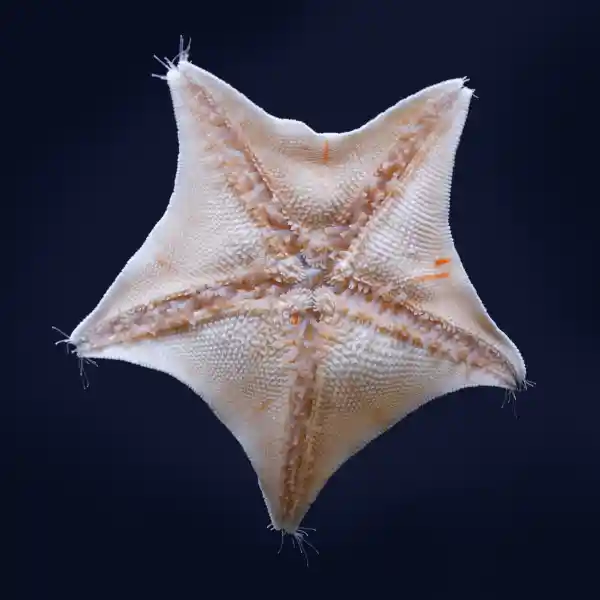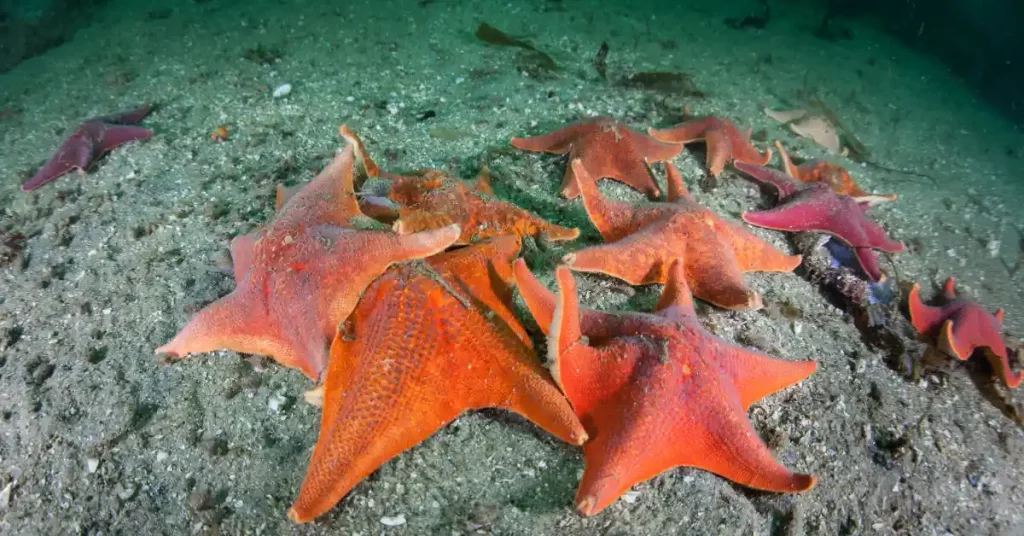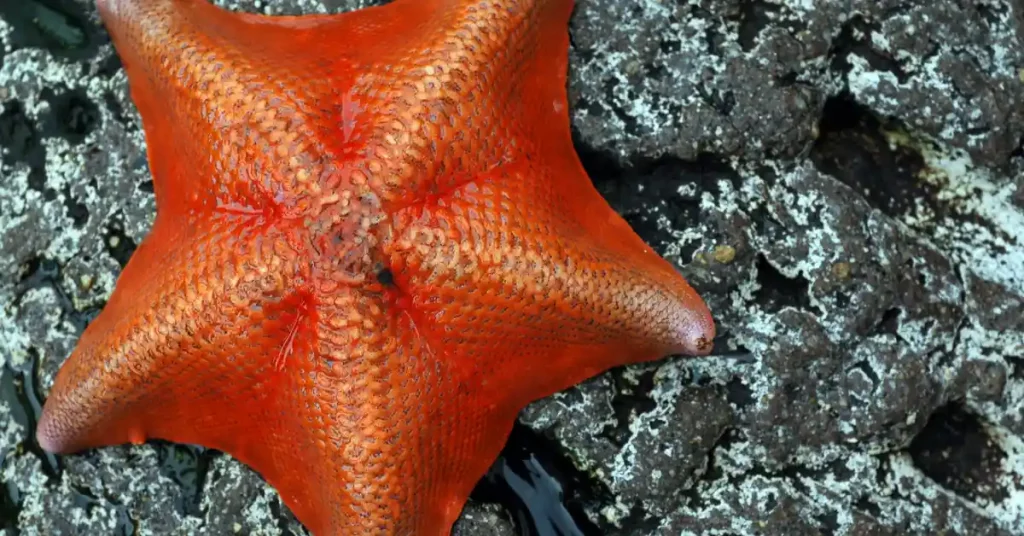The bat starfish (Patiria miniata) is one of the most beautiful species of starfish. Patiria miniata, is one of the finest aquarium specimens. Its distinctive features, colors, and vivacity make it a favorite with every aquarist.
The scientific name for this starfish is Patiria miniata, also known as bat starfish or webbed starfish. It is a species of starfish that belongs to the family Asterinidae. It gets its name from its resemblance to a bat. The Bat Star is found from Alaska to Baja California and can adapt to cooler waters than most other sea stars. While it is fairly easy to care for, it does require some special attention. The Bat Starfish has been commonly called by several other names, such as Webbed Star, Sea Bat, Broad Sea Star, Spiny Sea Star, to mention a few.
This starfish is beautiful, charming, and very easy to care for marine life. Each one of them is unique, so expect variation in coloration and pattern. Bat star is a constellation of the “starfish” family. It has been listed in the CITES Appendix II since 2006, which restricts international trade and increases its need for conservation. This is a complete species profile of a Bat Starfish and a care guide for beginner aquarists interested in following the captive care of the Bat Starfish, Patiria Miniata.
Appearance and Behaviour
The bat starfish is a fascinating creature. Bat stars are five-pointed starfish that can vary in color from orange to brown. They have a broad, disc-like body with short arms, much like a bat’s wing. They are considered to be the most colorful of all starfish species. Bat stars have radial symmetry, which means they have no front or back end and can move in any direction. They use their tube feet for movement and for “sticking” to things.
The Webbed Star (bat starfish) can grow up to 28 inches in diameter, but a common diameter is between 6 to 12 inches. The average lifespan is about 10-15 years. Bat stars are one of about 40 species of sea stars that have an obvious central disk. The arms of bat stars grow from this central disk and have many long, slender finger-like projections that overlap when the animal is at rest. Bat star arms can reach up to 30 cm (12 inches) in length (Aguirre et al., 1999). The oral surface has a series of plates surrounding the mouth and a series of spines running down each arm.
They are typically orange to reddish or brown in color and have small white or yellow spots on the upper surface of their arms. They may be brightly colored or greenish when living under strongly lit conditions in shallow water.
Diet: What do bat stars eat?
Bat stars are omnivores and scavengers. They feed on invertebrates, zooplankton, bryozoans, and other small marine animals. They also feed on detritus and other organic matter in the water that they find by using their tube feet. Bat stars are night feeders. They can be fed a wide variety of meaty foods such as shrimp, squid, krill, mussels, and clams. Brine shrimp is an ideal food for young bat stars, but they will grow faster if given a more varied diet.

Feeding them with a variety of frozen foods that are available online or at your local fish store will ensure a healthy diet. They should be fed twice daily, but do not overfeed as this can lead to bloating (bloated fish will have a swollen look around their belly area).
They will not eat fish or other potential predators but they do eat small invertebrates, such as mussels, snails, and clams. Bat starfish are also scavengers, often consuming dead organisms that they find on the ocean floor.
Bat starfish feed everything from their stomach onto the prey to digest it outside their body. Their stomach is covered with hundreds of tiny tube feet that push food into the mouth. This is particularly effective against bivalves with two shells that can be pried open.
Reproduction and Growth
A sexless organism, the Bat Star can reproduce sexually as well as ‘asexually’. During sexual reproduction, the male gamete and female gamete are transferred to each other through their gonopore (the location of their genitals).
Webbed Stars reproduce during the mating season. During this time, both males and females release eggs and sperm into the water. The gametes fuse and develop into free-swimming larvae. The larvae have a plank-tonic stage that drifts in the ocean current sometimes for up to six months. After that, they settle on hard substrates in shallow waters to grow into adults.
They are dioecious, meaning they have separate male and female sexes. The sexes mature at different sizes. Females mature at a larger size than males do.
Bat sea eggs are fertilized internally. After fertilization, the eggs grow in two layers of tissue on the outer surface of the arms of the bat star. The larvae that develop from this egg tissue look like small bat stars with small stumps for arms. They will eventually metamorphose into adult bat stars, but first, they need to find a suitable location for settling down.
Once the larvae find a suitable location for settling, they metamorphose into juvenile bat stars and begin their life as an adult with four arms. Adult bat stars can reproduce after about two years from the time they settled on the ocean floor as juveniles.
Breeding and Care Tips
The bat stars are gonochoristic, meaning they have separate sexes. They typically reproduce in late spring and early summer by releasing their eggs and sperm into the water column. Fertilized eggs will then settle onto hard substrates or rocky surfaces where they will develop into free-living larvae before changing into juvenile stars.
They do not rely on asexual reproduction by fragmentation for population maintenance. In fact, fragmentation is very uncommon in this species because the arms can regenerate after being separated from the central disc.
Unlike most other starfish, the Bat starfish is extremely easy to care for and is, therefore, a great addition to any marine aquarium. The Bat Starfish is capable of thriving in both reef and fish-only aquariums. Because they are nocturnal feeders, they will not compete with your fish for food.
The Bat Starfish is incredibly long-lived, making them an excellent addition to any aquarist’s collection. They are very active creatures, but do not have an aggressive temperament and will not attack other animals in your tank.
Because the Bat starfish has both a respiratory system and gills, it can survive with or without water circulation through its body. This means that the Bat Starfish can withstand stagnant water conditions without significant health problems.
This sea star is a curious and fun species of starfish that many aquarists enjoy. They are covered in small spines and have an omnivorous diet. They are peaceful, slow-moving, and easy to care for, making them great for most reef tanks.
Bat Star Habitat and Tank Requirements
The natural habitat of bat stars is the ocean floor, where they feed on marine mollusks, sponges, worms, and crustaceans. They are nocturnal animals, and their coloration may vary with their diet or environment. You can find them in the subtidal zone of the Pacific Ocean. They range from Alaska to Mexico.
Bat stars are usually found in rocky intertidal zones, but can also be found in eelgrass beds and mudflats. Most commonly found in sand or mud substrates, so providing enough substrate will allow your bat star to have a safe place to hide out when it feels threatened. If a predator comes too close, your bat star will drop down below the sand and escape danger.
The Bat Star tank needs to be large, at least 100 gallons and should have plenty of rockwork for climbing. It is a good idea to add some shallow caves or crevices where the starfish can rest during the day. The aquarium should be well-filtered and the water should be kept clean by changing 15% of the water per week.
These are generally peaceful toward fish tank mates. However, you should avoid housing them with aggressive species and other predatory animals that may eat the bat star.
The Bat sea star can be kept in groups of multiple specimens if the tank is large enough to accommodate them all without overcrowding. They will typically get along fine as long as there is enough food and space.
Patiria Miniata: Hairless Water Bat
The Bat Starfish is also known as the Patiria Miniata. They are very unique and stunning starfish. When they are out of the water, they will curl up. They don’t have any hairs on their bodies, but they do have hundreds of tiny tube feet that look like hairs, hence their nickname, “hairless water bat.”
The Patiria Miniata has no spines on its body, but rather tiny bumps all over. The bumps actually help protect this brittle little asteroid from predators and other threats in the wild. The Bat is usually grey or dark brown in color, but they can be found in several different colors throughout their range in the Pacific Ocean and the North American Coasts.
This bat starfish is also known as the hairless water bat and the common grey sea star. This type of starfish is basically just a regular sea star, but it has a different shape and color than most other types of sea stars. The bat starfish is usually light to medium grey in color. It can also be light green or even yellowish in some cases.

Fun Facts about Bat Stars
A multi-armed starfish
Bat starfishes are multi-armed starfishes that are not only very attractive but also have a great ability to regenerate.
An echinoderm that moves with the water’s current
The bat starfish (Patiria miniata) is an echinoderm that moves with the water’s current. They generally have five limbs, though some can grow more, and they eat algae and small animals.
A predator of snail and mussel species
Bat stars are voracious predators. They prey upon a number of species, including clams, mussels, snails, and chitons—virtually any sort of mollusk that cannot retreat into its shell fast enough to avoid being grabbed is fair game.
A habitat-specific species
The interactive Bat Starfish profile is a habitat-specific species that introduce the fish, and its profile features, along with the aquatic environment it thrives in, to provide a clear understanding of marine life.
It is found in shallow waters off the Pacific coast of North America.
The bat starfish is found in shallow waters off the Pacific coast of North America, from Alaska to Baja California. Stars live around rocks or are buried in the sand on the ocean’s bottom.
Foraging near the water’s surface
Bat starfish are found in the intertidal zone, where they forage along the water’s surface or in mid-water. Their calcium carbonate skeletons make life among the rocks, coral, and sand possible.
Forming large groups called “musters”
Bat starfish are found along a thin strip of the northern Pacific coastline and tend to form large groups called “musters.” There are many ways to help protect them, from picking up trash on the beach to adopting an area.
Long, narrow ossicles that form a skeleton resembling a bat’s arms
These starfish have long, narrow ossicles that form a skeleton resembling a bat’s arms. Bat starfish have excellent survival skills that allow them to withstand harsh conditions. They can regenerate limbs and even change their color to camouflage themselves in response to environmental conditions.
The forking of the rays is used to propel it through the water
The five arms of the bat star grow out of a central disc, and the tips of some arms are forked. So the forking of the rays is used to propel it through the water or catch prey.
Bat starfish – Frequently Asked Questions
What is the translation for Patiria Miniata?
Patiria Miniata is the scientific name. The common name is Bat Star. The translation for Asterina is star-like, and miniata means colored. The Patiria Miniata is commonly referred to as the Bat Starfish, Webbed Sea Star, or Sand Sifting Sea Star. It is one of the most common types of starfish found in aquariums, and it is also one of the more interesting types of starfish.
Do bat stars eat plankton?
Yes, Bat stars eat plankton. The Bat stars are not filter feeders, but they do graze on plankton. Bat stars will also eat algae and scavenge for dead or injured sea creatures.
Does a bat star eat kelp?
The bat star is a carnivorous sea star and will eat anything it can catch. They are scavengers and also feed on dead animals. Bat stars have a large appetite and will hunt all night long.
They do not feed on kelp, but instead eat the creatures that live on it. .Bat stars can be fed small amounts of kelp, lettuce, peas, and other vegetables as this will help supplement their diet.
How long do bat starfish live?
A bat starfish, or Patiria mianta, can live between 10 and 15 years. The average lifespan of a bat starfish is approximately 12 years.
The size of the bat starfish can vary widely depending on how much food it has available to eat. The size of a fully grown bat starfish ranges from 6 inches to 1 foot in diameter.
Is a bat star a producer or consumer?
The bat star is a producer. It uses photosynthesis to create its own food. The bat star is a type of sea star that has five arms and superficially resembles a bat with its outstretched limbs. The small bumps that cover the bat star’s skin give it a furry appearance and help distinguish it from other species of sea stars.
What phylum is a bat star?
Bat stars are members of the phylum Echinodermata, which includes all sea stars, brittle stars, sand dollars, and sea urchins. Echinodermata literally means “spiny-skinned.” This phylum includes animals such as sea cucumbers and sand dollars. There are more than 7000 different species in this phylum, and they are all marine animals. The name echinoderm comes from the Greek words echinos, which means “hedgehog,” and derma, which means “skin.”
Conclusion
Bat Starfis is an interesting species of sea star. It is quite unique in appearance and behavior, so much so that it can be distinguished from the other starfish within its genus. The distinct characteristics this species possesses make it a very intriguing creature to observe. It is important for future generations to be educated about bat stars like this one in order to further understand health and science.
Overall, bat stars are truly incredible creatures of the deep and an interesting species to keep as an ocean aquarium resident. They will be sure to add a lot of character and personality to your fish tank or aquarium!
